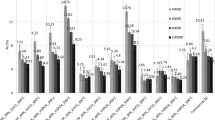Conclusions
-
1.
Some features of the properties and adsorption of water vapor by carbon sorbents induced by a change in the properties of the adsorbate due to an increase in the number of hydrogen bonds on filling of the adsoprtion area were examined.
-
2.
The initial segment of the adsorption isotherms was calculated with the equation from the theory of volume filling of micropores and it was shown that the properties and adsorbability of water vapor on carbon sorbents at low relative pressures are similar to low-boiling gases with molecules of similar size.
-
3.
As the adsorption area fills, the increase in the number of hydrogen bonds formed correspondingly decreases the hypothetical saturated vapor pressure, which is responsible for the S-shape of the isotherm of adsorption of water vapor by carbon sorbents.
Similar content being viewed by others
Literature cited
R. A. Horne, Marine Chemistry: The Structure of Water and the Chemistry of the Hydrosphere, Wiley (1969).
V. A. Pchelin, Vestn. Mosk. Univ.,2, 131 (1972).
Short Encyclopedia of Chemistry [in Russian], Vol. 1 (1961), p. 606.
J. D. Bernall, Proc. Roy. Soc.,250A, 299 (1964).
L. Pauling, General Chemistry, 3rd edn., W. H. Freeman (1970).
L. Pauling, Nature of the Chemical Bond and the Structure of Molecules and Crystals: An Introduction to Modern Structural Chemistry, 3rd edn., Cornell University Press (1960).
H. S. Frank, Proc. Roy. Soc.,202A, 323 (1950).
H. S. Frank and W. J. Wen, Disc. Faraday Soc.,24, 133 (1957).
H. S. Frank, Proc. Roy. Soc. (London),247A, 481 (1958).
G. Nemethy and H. A. Scheraga, J. Chem. Phys.,36, 3382 (1962).
L. Pauling, The Nature of the Chemical Bond, London (1960).
Chemist's Handbook [in Russian], Vol. 1, GNTI, Moscow-Leningrad (1962), p. 917.
M. M. Dubinin, Progr. Surface Membrane Sci.,9, 1 (1975).
L. Pauling, Science,134, 15 (1961).
M. M. Dubinin, in: Surface Chemical Compounds and Their Role in Adsorption Events [in Russian], Izd. Mosk. Univ., Moscow (1957), pp. 9–33.
A. V. Kiselev and Ya. I. Yashin, Gas Adsorption chromatography [in Russian], Nauka, Moscow (1967), p. 256.
J. R. Dacey, J. C. Clunic, and A. G. Thomas, Trans. Faraday Soc.,54, 250 (1958).
R. Sh. Vartapetyan, A. M. Voloshchuk, M. M. Dubinin, and S. M. Kalashnikov, Izv. Akad. Nauk SSSR, Ser. Khim., 44 (1981).
O. Kadlets, in: Adsorption in Micropores [in Russian], Nauka, Moscow (1983), p. 75.
Author information
Authors and Affiliations
Additional information
Translated from Izvestiya Akademii Nauk SSSR, Seriya Khimicheskaya, No. 6, pp. 1225–1231, June, 1984.
Rights and permissions
About this article
Cite this article
Chepurnoi, S.G. Features of the adsorption of water vapor by carbon sorbents. Russ Chem Bull 33, 1123–1128 (1984). https://doi.org/10.1007/BF00948972
Received:
Issue Date:
DOI: https://doi.org/10.1007/BF00948972




